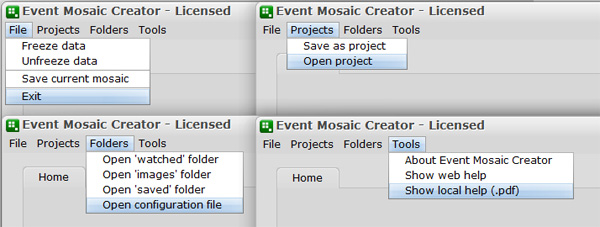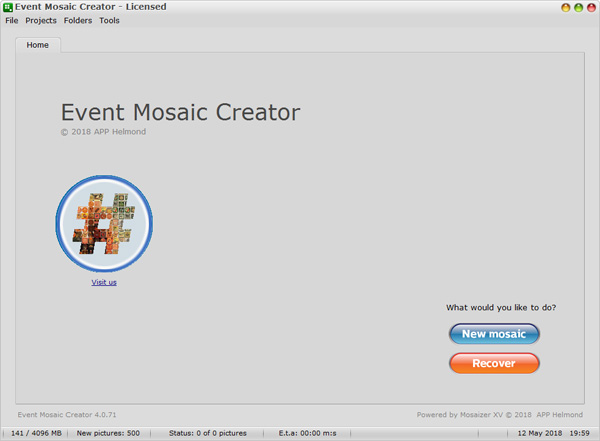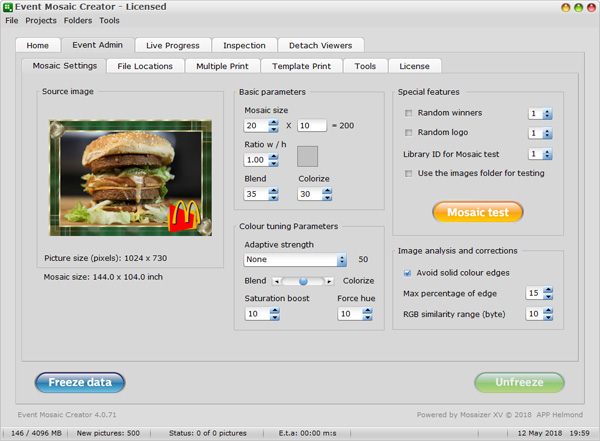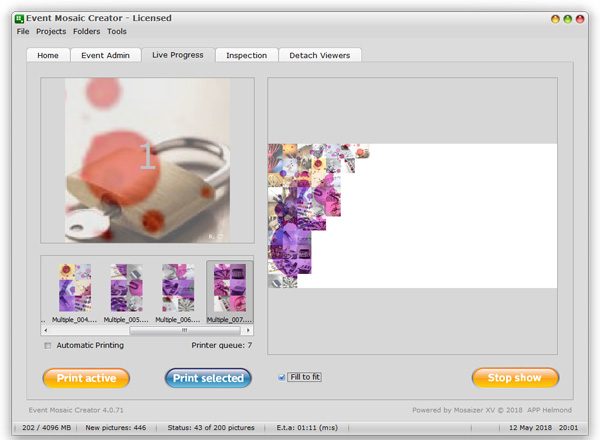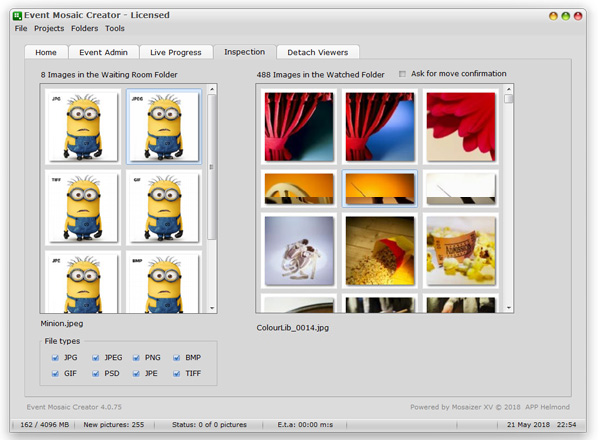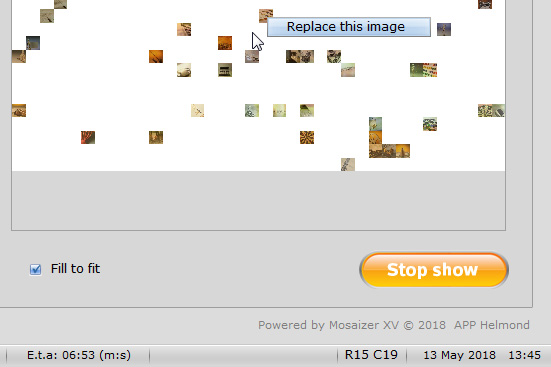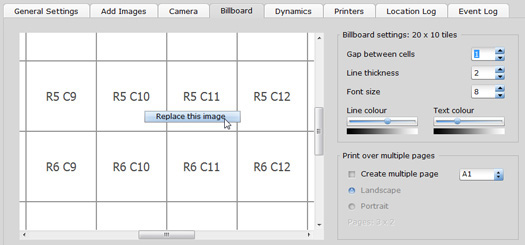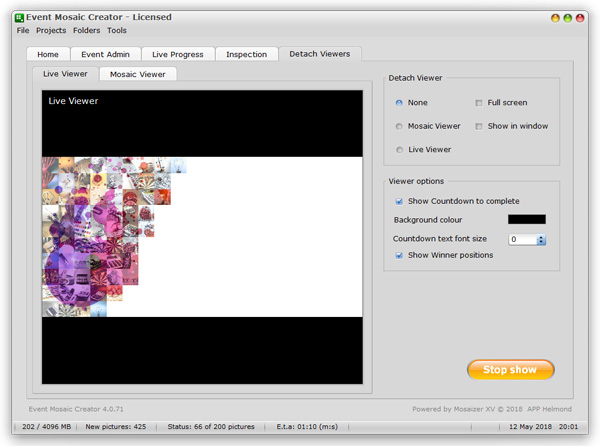 Event
Mosaic Creator -
Help Event
Mosaic Creator -
Help |
 Event
Mosaic Creator -
Help
Event
Mosaic Creator -
Help
Functions and features
SpecialThe
application is build in functional tabs. Some of the tabs have also tabs
('sub-tabs') in which specific functionality is managed. On top you find a
simple shortcut menu bar, with a few application-wide functions, such as opening
the help documentation. There are 7 main
tabs: On the top of the
application's window, also a menu bar is seen. The menu bar has a couple of
additional and useful functions: 1. The Home tab
This tab is shown at the start of the application. You must
make a choice to use the application. The choices are New
mosaic or Recover. The first choice will start
a fresh new mosaic event, for which you must first set all the desired
parameters. The second choice will resume from a previous session (= the last one active before you closed the application), where all the settings are
recovered, and ready to resume the mosaic build up, printing, etc. 2. The Admin
tab This tab has 6 sub tabs.
The details are described in the tutorial (here). Some other
details are described here. 3. The Live
Progress tab This tab
has 3 placeholders, each of which is used to follow the progress of the mosaic
being built up, and the status of printing
the pictures. The image top-left shows the result of the
processed image. In case a multiple page print was selected (as shown in the
above screenshot), also the sequence number is shown (here #1 of 1). This
number represents the progress of completing a print page with multiple images. For
single print template the complete image, including template is shown (no
progress number is shown). The bottom-left overview shows the print queue. Here you
clearly see prints of 2x3 images. The checkbox Automatic
printing will send each ready available
print to the selected printers (see here
for more details of selecting multiple printers, and how to speed up printing).
If this option is inactive, this overview will show a growing amount of
images, waiting to be printed. To manually print images, you can also click on
any of the images in this overview, and then press the Print
sticker button. It will print the selected image, and remove it from this
queue.
The
large mosaic area on the right shows the progress of filling the mosaic. The sequence
of placement is set in the tools section, where the user can select
from 'optimized per tile', 'fully random', or 'sequenced, following a
so-called density map image where the darkest pixels correspond to the locations that are placed first, gradually down to the white parts, which are placed
last. Note: Please be ware that the amount of RAM taken by the
application will increase with increasing amount of images in the printere
queue. Each image will be internally stored (as a thumbnail), before it can be
seen in the interface. It won't be much, but as can be seen, already 200 MB is
used by the application. The used RAM consists of internal bitmap processing
(always uncompressed), templates and other ovehead data, such as mosaic viewers
(there are 3 of them), and log data. Several hundreds, or even thousands of images can take a quite a lot of active
RAM. Zoom and pan the mosaic
The 'Live Progress' mosaic viewer has zoom and pan
functionality. Below the viewer a 'Fill to fit' checkbox
is seen. When ticked the mosaic image is completely filling the available
area, and no zoom/pan is possible. When unticked a zoombar becomes visible.
Now you can zoom in and out, and by press-moving the mouse also panning is
possible. Re-ticking the 'Fill to fit'
checkbox will disable zoom/pan again, while removing the
zoombar. 4. The Inspection
tab
Here you find two
explorers: The box with file types on the left is a useful tool to
select the images, where the checkboxes act as filters of the filetypes that are
accepted by the application. The change of selection is immediate. Please be aware that
.PNG and .PSD files can be transparent. Some .PNG files are incorrectly saved and
may show large coloured stripes or blocks. The .PSD files are read as
composite images, meaning: flattening all the visible layers. Also .GIF images are read, but when animated GIFs
are found it will only take the first
frame.
The left folder is used as a temporary watched folder.
This 'Waiting Room'
folder is the folder where your #tag grabber
copies the images from the #tags, unfiltered. The Waiting room is actually a very
elegant way to assure that only appropriate images are used for the mosaic.
Only by selecting and dragging images from left to right, the watched folder
does what it normally does: in case an image is found, the application is
triggered to read, process and place the image in the mosaic, and adding it to
the printer queue. Just like what has been described in the
tutorial.
The elegancy
of this approach is that you
select your watched folder:
if you select the 'images' folder as the 'Watched' folder then no inspection is
done, and the images are processed when they arrive from your #tag grabbing
software, unfiltered. If you select the Waiting Room folder
as the target folder for your #tag grabber, nothing happens because the images
are not automatically copied to the 'images' folder. Only
manual interaction can now trigger the image processing and mosaic
build-up.
A second feature of the Inspection tab is to ability to remove an image from the
watched folder. This is done by selecting and dragging the (inappropriate) image
from the right to the left folder. So basically you put an image back in the
Waiting Room. Now, two actions can happen: you get an
information pop-up indicating that the selected image was already placed, and
that the image will be replaced. The other action is that the image is simply
removed from the right, and moved to the left folder. In the latter case the
image was not yet processed, and then a replacement image is not
required.
A few aspects are important to share, and
some basic rules must be
followed: There are several ways to remove of
change a placed image
In the above text, tile
replacement is done
from the Inspection tab. The tile selection
takes place based on the image itself. There are different ways to replace a specific
image, where you can replace a cerrtain image at a certain location. It is particularly
useful
if you want to select an image at a location, without
having to search for that image in the inspection tab, as explained
above.
There are three ways to identify an image on a spcified
location:
When you have correctly followed any of these three
approaches, and you resume the mosaic build-up again, the next available image
will processed and printed, and positioned in the indicated location. After the
replacement is completed, the information will be discarded, and the 'Add specific image'
data is removed, and the little (green) icon has
disappeared.
Note: this way of image replacement does not
work with the optimized image placement, only with sequenced
placement. 5. The Detach
Viewers tab
In
this tab three key features are managed. The first (Viewer detachment) being the possibility to detach a
viewer of choice from the application, meaning: a separate window will be opened
and the viewer of choice will be shown in that window. The second is to add a
countdown number. This number shows how many images still need to be placed. This
may be a nice interaction with viewers
at the event. The third feature
is
to also show winner locations (shown as small present logos). In
case a winner position is selected, that uploader
person will receive a
small present.
